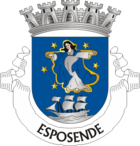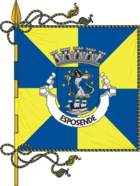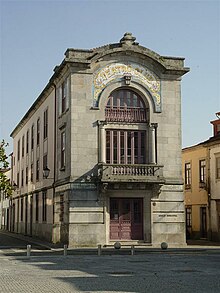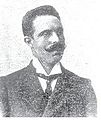Esposende
| Esposende | ||||||
|---|---|---|---|---|---|---|
|
||||||
| Basic data | ||||||
| Region : | Norte | |||||
| Sub-region : | Cávado | |||||
| District : | Braga | |||||
| Concelho : | Esposende | |||||
| Freguesia : | União das Freguesias de Esposende, Marinhas e Gandra | |||||
| Coordinates : | 41 ° 32 ′ N , 8 ° 47 ′ W | |||||
| Postal code : | 4740-233 | |||||
| politics | ||||||
| Website: | www.freguesiaesposende.pt | |||||
| Esposende district | ||||||
|
||||||
| Residents: | 34,254 (as of June 30, 2011) | |||||
| Surface: | 95.41 km² (as of January 1, 2010) | |||||
| Population density : | 359 inhabitants per km² | |||||
| Number of municipalities : | 9 | |||||
| administration | ||||||
| Administration address: | Câmara Municipal de Esposende Praça do Município 4740-223 Esposende |
|||||
| President of the Câmara Municipal: | António Benjamim da Costa Pereira ( PSD ) | |||||
| Website: | www.cm-esposende.pt | |||||
Esposende is a city in northern Portugal . The urban area consists of the three municipalities Esposende, Gandra and Marinhas .
The Rio Cávado flows into the Atlantic Ocean here. The place is also known for its beaches.
On September 29, 2013, the municipalities of Esposende, Marinhas and Gandra were merged to form the new municipality of União das Freguesias de Esposende, Marinhas e Gandra . Esposende is the seat of this newly formed community.
history
Finds prove a prehistoric settlement. The menhir São Paio de Antas and in particular the excavation site of the Castro de São Lourenço settlement from the Castro culture should be mentioned . The area belonged to the Suebian Empire in the early 5th century , then to the Visigoth Empire . The etymology of the place name indicates a corresponding Germanic origin of the name of the place, which was originally called Hispanusindus and then Spanusinde . Esposende was first officially mentioned in a document from 959, as a village near the salt pans of Villa de Fano . 1108 named an inheritance document of a monastery, the Mosteiro de Vairão , the place Esposende, in which the children of Paio Godins and Goutinho Nunes divided areas between Esposende, Braga and Vila do Conde.
In the royal surveys of 1220 Esposende was listed as a small town in the municipality of Zopães (now Marinhas ). Bishop Pedro helped all parishes in the Archdiocese of Braga to become independent, with the exception of Esposendes, which was spun off from the administrative parish of Marinhas and became independent only after several attempts and through the initiative of Frei Bartolomeu dos Mártires. On August 19, 1512, Esposende was raised to a small town ( Vila ) and the seat of its own district. In the further course of the Portuguese voyages of discovery , Esposende's boom increased significantly, especially as a place of sea trade, shipbuilding and salt production, but agriculture and grazing cattle also contributed to the economic development. King D. Sebastião extended the city rights of Esposende with a document dated October 5, 1573.
The increasing importance of Esposende led to the settlement of a district court in 1898. On August 19, 1993, the previous small town (Vila) was finally elevated to a town ( Cidade ).
administration
The circle
Esposende is the seat of a district of the same name ( concelho ) in the Braga district . On June 30, 2011, the district had 36,700 inhabitants on an area of 95.4 km².
The neighboring areas are (starting clockwise in the north): Viana do Castelo , Barcelos , Póvoa de Varzim and the Atlantic Ocean .
With the regional reform in September 2013, several municipalities were merged into new municipalities, so that the number of municipalities decreased from 15 to nine.
The following municipalities ( Freguesias ) are in the Esposende district:
| local community | Population (2011) |
Area km² |
Density of population / km² |
LAU code |
|---|---|---|---|---|
| Antas | 2,221 | 9.07 | 245 | 030601 |
| Apúlia e Fão | 7,301 | 16.29 | 448 | 030616 |
| Belinho e Mar | 3,199 | 8.95 | 358 | 030617 |
| Esposende, Marinhas e Gandra | 11,111 | 17.31 | 642 | 030618 |
| Fonte Boa e Rio Tinto | 1,944 | 10.38 | 187 | 030619 |
| Forjães | 2,767 | 8.30 | 333 | 030608 |
| Measured | 1,078 | 5.57 | 194 | 030610 |
| Palmeira de Faro e Curvos | 3.214 | 11.04 | 291 | 030620 |
| Vila Chã | 1,419 | 8.50 | 167 | 030615 |
| Esposende district | 34,254 | 95.41 | 359 | 0306 |
Population development
| Population in the Esposende district (1801–2011) | |||||||||
|---|---|---|---|---|---|---|---|---|---|
| 1801 | 1849 | 1900 | 1930 | 1960 | 1981 | 1991 | 2001 | 2011 | |
| 4157 | 12,545 | 15.161 | 19,452 | 23,966 | 28,652 | 30.101 | 33,325 | 34,361 | |
Municipal holiday
- August 19th
Town twinning
-
 Ozoir-la-Ferrière , France
Ozoir-la-Ferrière , France -
 São Domingos , Santiago Island , Cape Verde
São Domingos , Santiago Island , Cape Verde
traffic
The city is located with its own junction on the A28 motorway , which leads north from Porto to Galicia in Spain .
The nearest railway connection is the Barcelos train station, about 15 km to the east, on the Linha do Minho line .
Esposende is integrated into the national long-distance bus network of Rede Expressos .
Local public transport in the district is served by bus lines operated by the Litoral Norte company.
sons and daughters of the town
- António Rodrigues Sampaio (1806–1882), journalist and liberal politician, multiple interior minister, briefly prime minister in 1881
- Tiago Augusto de Almeida (1864–1936), doctor and university professor
- António Rodrigues Alves de Faria (1871–1949), entrepreneur, made a fortune in Brazil
- Fonseca Lima (1874–1945), Republican politician
- Manuel de Barros (1908–1971), astronomer
- Abel Vinha dos Santos (1912-1939), writer
- Viana de Lima (1913–1991), architect
- José Gonçalo Correia de Oliveira (1921–1976), politician, multiple minister in the authoritarian Estado Novo regime
- João Maria de Oliveira Martins (1934–2011), conservative politician and engineer, multiple minister
- Bernardete Costa (* 1949), writer
- António Couto dos Santos (* 1949), politician and engineer, multiple minister
- Paulo Gonçalves (1979–2020), motorcycle racer, had a fatal accident at the 2020 Dakar Rally
- Ana Maria De Sá Fernandes (* 1987 in Vila Chã), football player
The painter Henrique Medina (1901–1988) and the writer António Correia de Oliveira (1878–1960) died in Esposende.
Web links
- Map of the Freguesia Esposende at the Instituto Geográfico do Exército
- City website , Portuguese, accessed May 6, 2010
Individual evidence
- ↑ www.ine.pt - indicator resident population by place of residence and sex; Decennial in the database of the Instituto Nacional de Estatística
- ↑ Overview of code assignments from Freguesias on epp.eurostat.ec.europa.eu
- ↑ Francisco Diniz, Alexandre Poeta, Conceição Silva, Lígia Pinto, Sónia Abreu: Relatório da cidade de Esposende Portugal. (PDF; 955 kB) utad.pt, December 2003, p. 2 , accessed on May 22, 2011 (Portuguese): "Zona A - Freguesias de Esposende, Gandra, Marinhas"
- ^ Publication of the administrative reorganization in the Diário da República gazette of January 28, 2013, accessed on October 1, 2014
- ↑ www.verportugal.net , accessed on February 16, 2014
- ↑ www.ine.pt - indicator resident population by place of residence and sex; Decennial in the database of the Instituto Nacional de Estatística
- ^ Publication of the administrative reorganization in the Diário da República gazette of January 28, 2013, accessed on March 16, 2014
- ↑ www.anmp.pt , accessed on February 16, 2014













